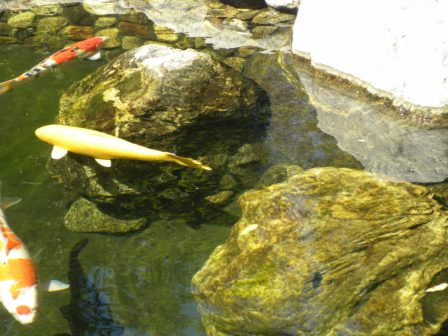If you have never been to Balboa Park’s Japanese Friendship Garden, it is one of the loveliest areas of the park. In September I heard Mark Halverson speak about Japanese Garden Art. Although I have seen many Japanese gardens in Japan, San Francisco, and in friends’ homes, Mark gave me a new appreciation and way to experience these gardens.
He began with its history. The “traditional Japanese garden” originated in China. Many events inspired and influenced its evolution, beginning around 600 AD until the end of the 1500’s. As Buddhism spread from China and Korea to Japan, so did the “aesthetic” of Chinese gardens begin to appear in the 700s. The four hundred years between the 12th and 16th centuries heralded the in the spread of Zen, the warlords’ rise leading to the decline of the Japanese royal family (Zen’s sense of responsibility and discipline attracted the rising class of warlords who sent the royal family away and ran the country themselves), and “the development and refinement of the formal tea ceremony” which, according to Mark, “has not changed one iota” in 500 years. These were some of the factors which eventually “culminated in [the traditional Japanese garden’s] highest art form.” Zen shifted the garden’s purpose from a place of recreation to one of contemplation.
This basis of traditional Japanese aesthetics is a sense of “restrained good taste,” called shibui or sukiya. Halverson says the Japanese understand this instinctively. The components of shibui are called wabi and sabi or wabi-sabi. Essentially, this is an indefinable term, partly because to the Japanese, the Western concept of “art” does not exist. For them it is form and design which implies, Halverson says, “art is synonymous with living, functional purpose, fine craftsmanship, and spiritual simplicity.” Japanese do not analyze or discuss art, no more than they would show emotion in public. They experience art. Mark quoted Leonard Koren, author of “Wabi-Sabi for Artists, Designers, Poets, and Philosphers in 1994,” “To fully explain the concept of wabi-sabi might, in fact, diminish it,”
Two of Japan’s religions, Buddhism and Shintoism, mirror the underlying factors in Japanese art or wabi-sabi. Buddhism is quiet and introspective religion whereas Shintoism is loud and aggressive. Wabi is more like Buddhism. It literally means simple, taken alone, poverty. It describes something unadorned, healthy, and natural, yet striving for perfection.
Using slides to illustrate his points, Halverson explained that nothing is installed in a Japanese garden until it has been pruned and nurtured to represent the essence of itself — not unlike having each item reach the perfection associated with the Westminster Best in Show dog. The object is also, like life itself, transient. Thus the garden needs constant attention to maintain its perfection. Trees are carefully pruned–as a dog is groomed – to reflect its optimum state. Crystal clear water–like that found in the Friendship Garden’s koi pond—also expresses the concept of perfection.
Using an odd number of items reflects imperfection in nature’s beauty. They will be arranged with more objects on one side, fewer on the other. Wabi materials are natural; the mechanics of making a garden flourish (grates, drains, plumbing and the like) are not natural, so they will be covered or hidden by natural materials such as rocks or pebbles. Halverson says, “Wabi describes the beauty inherent in fresh newness, the natural and verdant growth in the process of becoming.”
The other side of “restrained good taste” is sabi. Literally it means rust. In Zen, “The spiritual transcends the material. The material world is transient and continuously in a state of decline.” Over time items worn through time or “years of loving use” (rusted) were used in innovate ways and came to represent sabi. Old objects, with their history reflected in their patina, are seen as “venerable and beautiful.” Another way of conveying the passage of time is allowing lichen or moss to cover a stone. Even fences are allowed to age. This is the opposite of wabi.
Although Wabi-sabi has no rules, it reflects some basic concepts. Everything should appear organic: shiny or uniform materials are omitted or camouflaged. The key is natural. Materials should clearly show the passage of time yet remain expressive and beautiful. A second characteristic is freedom of form. Form should reflect “the physical properties of the materials used,” while everything should appear natural, not forced. Texture is the third property of wabi-sabi. Materials’ texture should be rough and uneven yet of high quality. Various textures should appear random. Fourth is space. Less is more in that each item is essential, empty space is important and part of the creation, and items should not be crammed together. Private spaces are also essential. Fifth is balance: uniformity and regularity do not reflect nature; everything should appear to be naturally balanced. The sixth property is sobriety. Impermanence may be used to add perspective and awareness of mortality. The finished product is not a reflection of ego; it is intimate, personal, humble and sincere.
Halverson’s lecture ended with seven Zen principles:
Fukinsei asymmetry
Kanso simplicity
Koko mature, venerable, austere
Yugen subtly profound (indirect, abstract)
Datsuzoku beyond conventional (surprise)
Seijaku quiet, calm, silent
These principles are apparent in Ikebana, Japanese flower arranging. They seem to permeate every aspect of Japanese culture.
In his booklet “Traditional Japanese Aesthetics,” copyrighted in 2010, Halverson concluded, “In a nutshell, the aesthetic behind the design of the traditional Japanese gardens can be described by the hierarchy of terms:
“?Shibui
“?Wabi-Sabi
“?The 7 Zen Principles”
Our Japanese Friendship Garden which could be called a Zen Garden in the “historical Zen philosophical basis of the garden design” is actually a traditional Japanese Garden following the aesthetics from the 16th century.
Category: Life Style








